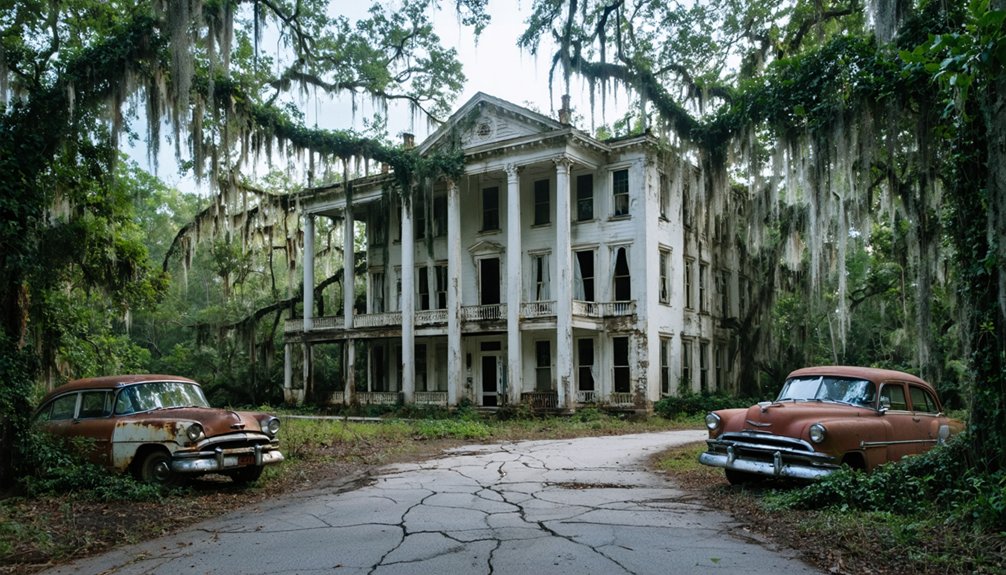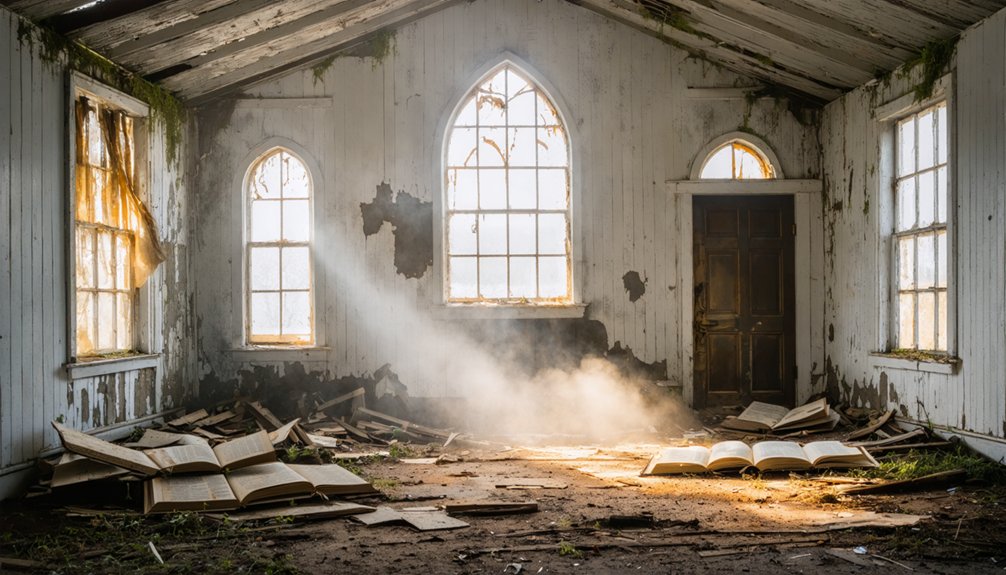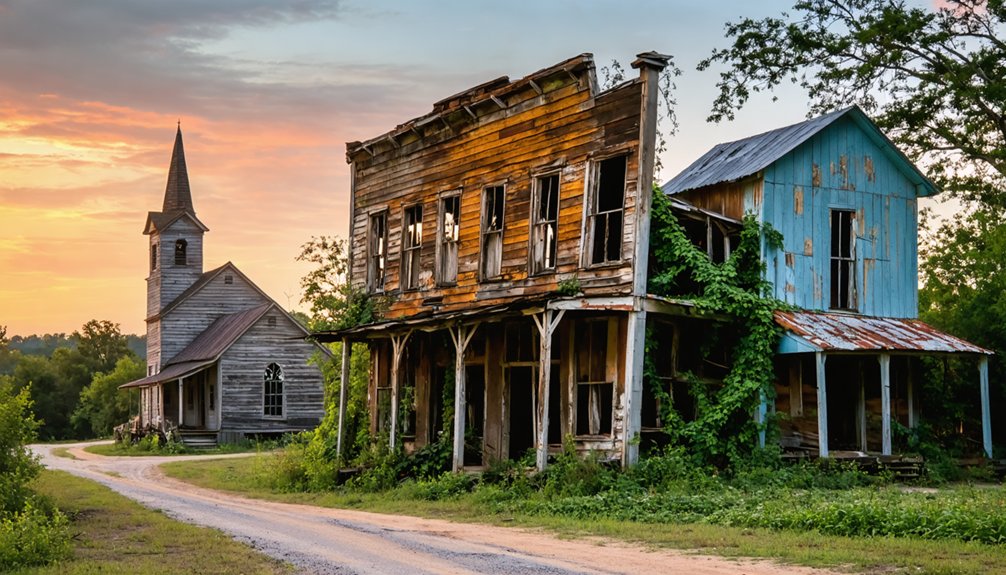When exploring abandoned Southern residential developments, you’ll encounter the aftermath of economic decline, natural disasters, and structural racism. Manufacturing job losses, Hurricane Katrina‘s displacement of entire communities, and historical redlining policies have created ghost neighborhoods throughout the region. Southern states show homeowner vacancy rates of 1.3% (above the national 1.1%), with rural Georgia reporting staggering 32% vacancy rates in some areas. These haunting landscapes reveal America’s complex socioeconomic challenges beneath their crumbling facades.
Key Takeaways
- Economic downturns and manufacturing job losses have created widespread residential abandonment across Southern states.
- Post-Katrina New Orleans exemplifies how natural disasters accelerated neighborhood abandonment with over 47,000 vacant housing units by 2010.
- Southern regions report alarming vacancy rates, with rural Georgia showing up to 32% vacancy in some counties.
- Historical patterns of redlining and racial discrimination contributed significantly to concentrated zones of abandonment in Black neighborhoods.
- Zombie properties have increased dramatically in Southern states, with Texas and South Carolina seeing over 40% growth rates.
The Rise and Fall of Southern Suburban Dreams

When examining the trajectory of Southern suburban expansion, one must understand the powerful convergence of economic, social, and infrastructural factors that created these once-thriving communities.
You’re witnessing the aftermath of post-WWII prosperity, when GI Bill benefits and FHA loans transformed homeownership from distant dream to tangible reality for many Americans.
These neighborhoods weren’t merely collections of houses—they embodied suburban nostalgia, promising safety, community, and upward mobility.
Yet beneath this idealized vision lay economic disparities shaped by redlining and exclusionary policies. As highways stretched outward, so too did suburban boundaries, fueled by automobile culture and developers’ ambitions.
When economic downturns hit, the fragile foundation cracked. Aging infrastructure, retail decline, and shifting demographics transformed these symbols of prosperity into abandoned reminders of fleeting American dreams. Cities like Pine Bluff exemplify this decline, with 12.5% population decrease between 2010 and 2020 leaving countless homes abandoned. The region’s history of architectural loss mirrors this residential decline, with once-magnificent structures like Windsor Ruins standing as haunting reminders of Southern grandeur.
Mapping the Ghost Neighborhoods of the Deep South
Across the forgotten landscapes of the American Deep South, ghost neighborhoods silently chronicle the region’s complex patterns of settlement and abandonment.
You’ll find these spectral communities mapped through sophisticated GIS technologies that overlay historical plats with modern satellite imagery. In places like Rodney, Mississippi and Picher, Oklahoma, local historical societies preserve detailed records of these vanishing settlements.
Historical mapping efforts reveal distinct abandonment patterns—economic collapse, environmental disasters, government actions, and infrastructure decay. The town of Rodney was completely abandoned when the Mississippi River changed course, cutting off vital transportation and commerce routes. Many of these abandoned spaces feature old mercantile stores with intact shelving that hints at their former commercial function.
Eroded economies, poisoned lands, government mandates, and crumbling roads write the epitaph for countless Southern communities.
When you explore Allendale’s empty streets or Carroll Parish’s plantation remnants, you’re witnessing sites documented through federal archives, county deed records, and crowdsourced platforms.
While many ghost town preservation efforts encounter barriers due to private ownership, dedicated volunteer groups continue documenting these sites, ensuring these lost neighborhoods aren’t erased from our collective memory.
Hurricane Katrina’s Lasting Impact on New Orleans Housing

You’ll find stark demographic shifts in post-Katrina New Orleans, where the city lost nearly 30% of its population, particularly in low-income communities of color.
Neighborhood recovery patterns reveal troubling disparities, with primarily white, affluent areas rebounding quickly while historically Black neighborhoods like the Lower Ninth Ward still show visible scars of abandonment nearly two decades later.
This uneven recovery trajectory has reshaped the city’s demographic landscape, transforming once-vibrant communities into partially abandoned neighborhoods where sporadic rebuilding exists alongside vacant lots and demolished housing stock. The housing market experienced a 14.4% value drop in the seven years following the hurricane, further complicating recovery efforts. The destruction of public housing complexes like St. Bernard and C.J. Peete created a severe shortage of affordable rental units, deepening the housing crisis for displaced residents attempting to return.
Population Exodus Patterns
Hurricane Katrina’s devastating impact on New Orleans in 2005 triggered one of the most significant population displacements in modern American history.
You’re witnessing the aftermath of a mass exodus where over 50% of residents fled, dropping the population from 460,000 to just 209,000 by 2006. Even by 2024, nearly 100,000 residents never returned.
This population migration created complex patterns—evacuees scattered across the country, with 25% relocating within 10 miles of their previous county while another 25% moved over 450 miles away. The city’s employment figures reflect this exodus, with jobs plummeting from 186,000 to 93,500 after Katrina.
Housing instability persisted as 47,738 units sat vacant by 2010. The city’s demographic landscape transformed permanently, with return rates varying dramatically by socioeconomic status. The government’s decision to demolish 4,500 public housing units left 16,000 families waiting for subsidized housing a decade after the storm.
Most striking is that 65 of 72 neighborhoods lost residents, including areas that didn’t flood, revealing Katrina accelerated a pre-existing urban decline.
Neighborhood Recovery Disparities
When examining New Orleans’ post-Katrina landscape, you’re confronted with a stark mosaic of inequitable recovery that reveals how disaster compounds existing social disparities.
The Lower Ninth Ward‘s continued struggle stands in sharp contrast to areas like New Orleans East, which rebounded more quickly, demonstrating how neighborhood resilience varies dramatically.
Only 26% of pre-Katrina public housing has been restored, while a mere 13% of units from the demolished “Big Four” developments have been replaced despite $585 million in recovery funding.
This uneven distribution of resources manifests in residential density patterns that remain visibly altered nearly two decades later.
The prioritization of certain areas over others has created a fractured cityscape where your chances of returning home depended largely on your neighborhood’s socioeconomic status before the storm hit.
The Road Home program’s payment structure based on pre-storm home values systematically disadvantaged Black homeowners who lived in historically undervalued neighborhoods, requiring a $62 million settlement to address this discrimination.
Economic Factors Driving Southern Property Abandonment
You’ll find that many abandoned Southern residential developments suffered from the one-two punch of manufacturing job losses and subsequent property tax foreclosures.
When textile mills, furniture factories, and other industrial employers shuttered operations across the Southern manufacturing belt, families lost stable middle-class incomes that had previously supported mortgage payments.
The resulting tax delinquencies often culminated in municipal foreclosures, creating clusters of abandoned properties that further depressed surrounding property values and accelerated neighborhood decline. This pattern mirrors the Sunbelt housing crisis where massive foreclosures led to unprecedented vacancy rates in previously prosperous cities like Phoenix and Orlando.
Decline in Manufacturing Jobs
The profound transformation of the Southern manufacturing landscape has served as a primary catalyst for residential property abandonment across the region.
You’re witnessing a manufacturing evolution where output has increased while employment has plummeted—South Carolina exemplifies this paradox with a 36% rise in manufacturing GDP despite losing 71,000 jobs since 2020.
This workforce transformation has been particularly devastating in traditional manufacturing communities.
The Southeast’s manufacturing employment share dropped from 16.4% in 1990 to just 8.4% in 2019, with states like North Carolina seeing declines of 16.6 percentage points.
While automation and AI drive productivity, they’ve left behind neighborhoods once supported by factory wages.
Though the South has attracted automotive manufacturing from the Rust Belt, these gains haven’t offset massive job losses in textiles and apparel sectors.
Property Tax Foreclosures
Property tax burdens have emerged as a crushing force driving residential abandonment across the South, creating a perfect storm of financial distress for homeowners.
You’ll find foreclosure trends accelerating as property values surge while incomes stagnate, particularly affecting fixed-income residents who simply can’t keep pace with escalating tax assessments.
Local governments have tightened collection enforcement while simultaneously, many Southern homeowners face the triple financial threat of skyrocketing insurance premiums, rising HOA fees, and increased property taxes.
This burden falls heaviest on those in coastal regions like Florida and Louisiana, where insurance costs have become prohibitive.
The aftermath? Abandoned properties dot the landscape, particularly in urban centers experiencing gentrification and rural communities with limited economic opportunities, creating neighborhood blight that further depresses surrounding property values in a devastating downward spiral.
The Hidden Costs of Vacancy for Southern Communities
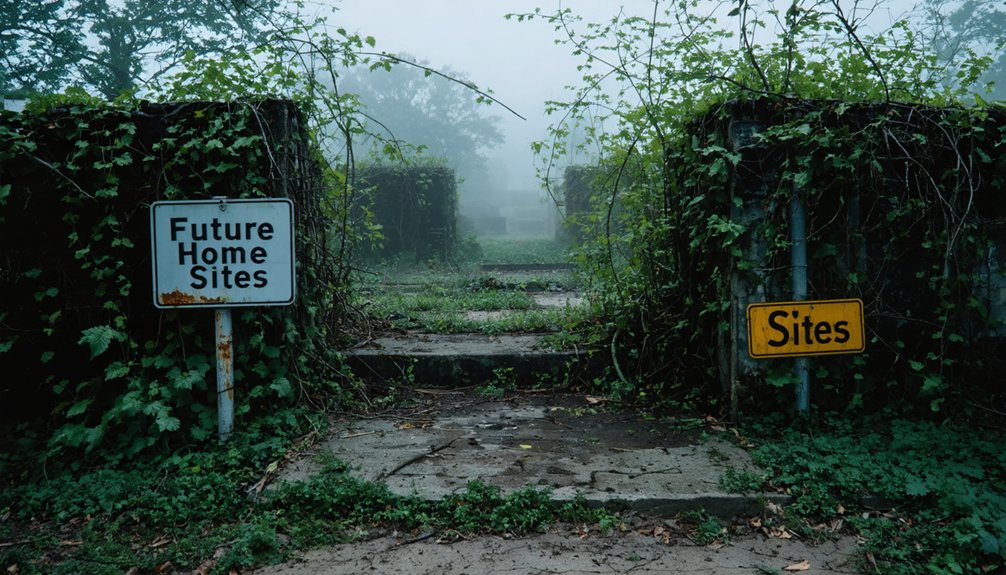
While developers often view abandoned residential projects merely as financial losses on their balance sheets, Southern communities bear a multifaceted economic burden that extends far beyond empty structures and overgrown lots.
You’re paying for these vacant properties through increased tax rates, as cities struggle to replace lost revenue—Baltimore alone loses $100 million annually.
Vacant properties silently drain public coffers, forcing taxpayers to shoulder the burden of municipal revenue gaps.
The ripple effects touch every aspect of your community’s economy. Home values plummet, with some areas experiencing 40% price drops.
Annual maintenance costs average $42,200 per abandoned project, while the potential for community engagement withers.
Policy innovation like South Carolina’s Abandoned Buildings Revitalization Act offers hope, providing tax credits up to $700,000 for rehabilitation projects.
Yet the immeasurable lost economic potential continues to hamper Southern communities’ revitalization efforts.
Racial Disparities in Southern Housing Abandonment
Throughout the complex history of Southern residential development, racial inequities have played a pivotal role in determining which neighborhoods face abandonment and which thrive.
You’ll notice that federal redlining policies systematically denied Black neighborhoods mortgage access, categorizing them as “dangerous” investments while enabling white flight to suburbs between 1940-1980. This mass exodus—15 million whites departing while only 5 million Blacks moved in—created collapsed housing markets and widespread abandonment.
The foreclosure crisis of 2005-2009 further intensified racial housing disparities, with Black and Latino neighborhoods suffering disproportionate foreclosure rates.
These abandoned developments became concentrated zones of poverty as absentee landlords neglected maintenance.
What you’re seeing today in many Southern communities are the physical manifestations of generational discrimination—abandoned structures standing as monuments to systematically engineered inequality.
Rural Georgia’s Alarming Vacancy Crisis

These racial housing inequities that have shaped Southern urban environments find their rural counterpart in Georgia’s countryside, where an unprecedented vacancy crisis now threatens the social fabric of entire communities.
You’ll find staggering vacancy rates reaching 32% in southern regions, with 85 rural counties exceeding 8% “Other” vacant properties—structures neither for sale nor rent, simply abandoned.
The crisis demands innovative vacancy solutions through:
- Addressing unmarketable title issues, particularly heirs’ properties
- Creating economic incentives where rehabilitation costs exceed market value
- Improving critical infrastructure including broadband and healthcare facilities
- Facilitating community engagement to counter youth outmigration
The geographic concentration of vacancies in southern Georgia correlates strongly with counties ranking lowest in health factors and those with higher Black populations, revealing how demographic pressures and socioeconomic challenges converge in this troubling rural phenomenon.
Potential Revitalization Strategies for Abandoned Developments
As abandoned residential developments continue to scar the Southern landscape, implementing thoughtful revitalization strategies has become essential for community renewal and economic recovery.
You’ll find that mixed-use redevelopment transforms obsolete properties while creating vibrant community hubs. Environmental remediation must address contamination early to prevent costly delays during revitalization efforts.
Community gardens and urban agriculture initiatives offer immediate, visible improvements that foster neighborhood engagement while providing productive uses for vacant parcels.
Transforming vacant lots into community gardens creates immediate neighborhood pride while putting unused land to productive purpose.
Through transparent community participation, you’ll guarantee developments align with local needs rather than imposing unwanted changes. Land banks effectively manage these properties, preparing them for strategic redevelopment.
Infrastructure upgrades support new investments, while public space improvements like green spaces enhance livability and attract further development.
These coordinated approaches transform abandoned sites into assets that serve the community’s vision for renewal.
Comparing Southern Vacancy Patterns to National Trends
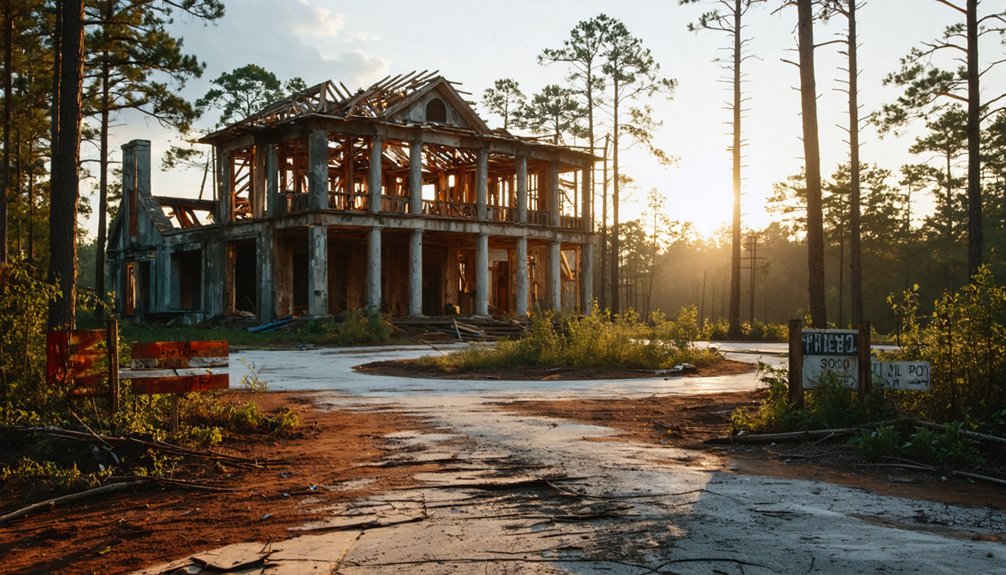
While revitalization strategies offer promising solutions for abandoned developments, understanding the broader context requires examining how Southern vacancy patterns compare to national trends. The South consistently displays higher vacancy rates than other U.S. regions, revealing distinctive regional housing dynamics.
When analyzing vacancy trends through regional comparisons, four key patterns emerge:
- The South’s 9.0% rental vacancy rate remarkably exceeds the national average of 7.0%, while other regions like the Northeast (5.2%) show much tighter rental markets.
- Southern homeowner vacancy (1.3%) remains higher than the national rate (1.1%).
- Zombie property increases in Southern states (Texas 51.9%, South Carolina 43.8%) outpace national averages.
- The South maintains strong homeownership (66.6%) despite high vacancies, suggesting complex economic factors affecting housing utilization.
Frequently Asked Questions
How Do Squatter’s Rights Apply to Abandoned Southern Developments?
You’ll face varying squatter laws in southern states, with timelines ranging from 7-20 years. Legal implications include required continuous occupation, tax payments, and hostile possession to claim abandoned developments.
What Wildlife Species Commonly Inhabit Abandoned Southern Neighborhoods?
You’ll encounter armadillos, coyotes, brown-headed cowbirds, and various opportunistic predators in abandoned neighborhoods. These urban wildlife species create complex ecological impacts as they establish new territories in once-developed areas.
Are Abandoned Southern Developments Attractive to Paranormal Investigators?
In summary, you’ll find these sites are ghost hunting meccas. Their tragic histories, structural decay, and documented eerie experiences—from LaLaurie Mansion to abandoned plantations—draw investigators seeking authentic paranormal phenomena.
How Do Property Values Fluctuate Near Abandoned Southern Developments?
Your property values will decline 8-9% within half a kilometer of abandoned developments, worsening as urban decay progresses. The longer these southern properties remain vacant, the wider this property market depression spreads.
What Safety Hazards Lurk in Abandoned Southern Residential Structures?
You’ll face deteriorating structural integrity, environmental contaminants, fire risks, and criminal threats in these spaces. Proper hazard identification reveals dangers from compromised foundations to toxic mold and unauthorized occupants.
References
- https://www.datacenterresearch.org/reports_analysis/population-loss-and-vacant-housing/
- https://www.lincolninst.edu/app/uploads/legacy-files/pubfiles/empty-house-next-door-full.pdf
- https://communityprogress.org/publications/vacant-properties-rural-georgia/
- https://unitedwaynca.org/blog/vacant-homes-vs-homelessness-by-city/
- https://safeguardproperties.com/zombie-foreclosures-remain-a-small-fraction-of-u-s-housing-inventory-in-first-quarter-of-2025/
- https://todayshomeowner.com/general/guides/highest-home-vacancy-rates/
- https://www.realtor.com/news/trends/cities-with-most-vacant-homes-lendingtree-study/
- https://www.youtube.com/watch?v=w69GWuEsJCE&vl=en
- https://decorhint.com/abandoned-year-old-mansions-hidden-across-the-american-south/
- https://theforgottensouth.com/houses/

